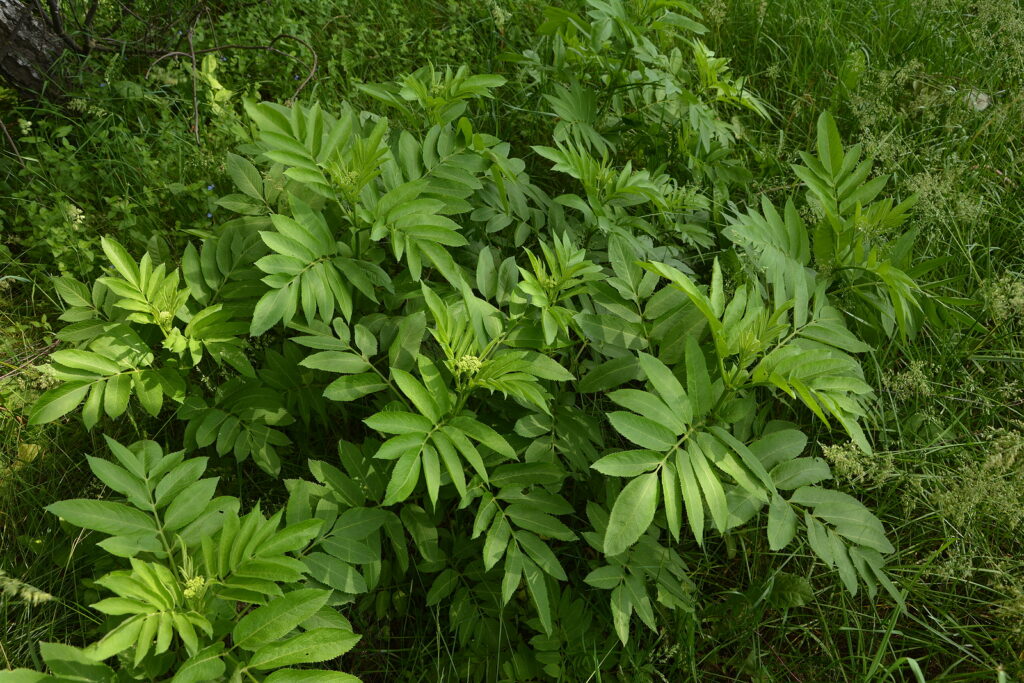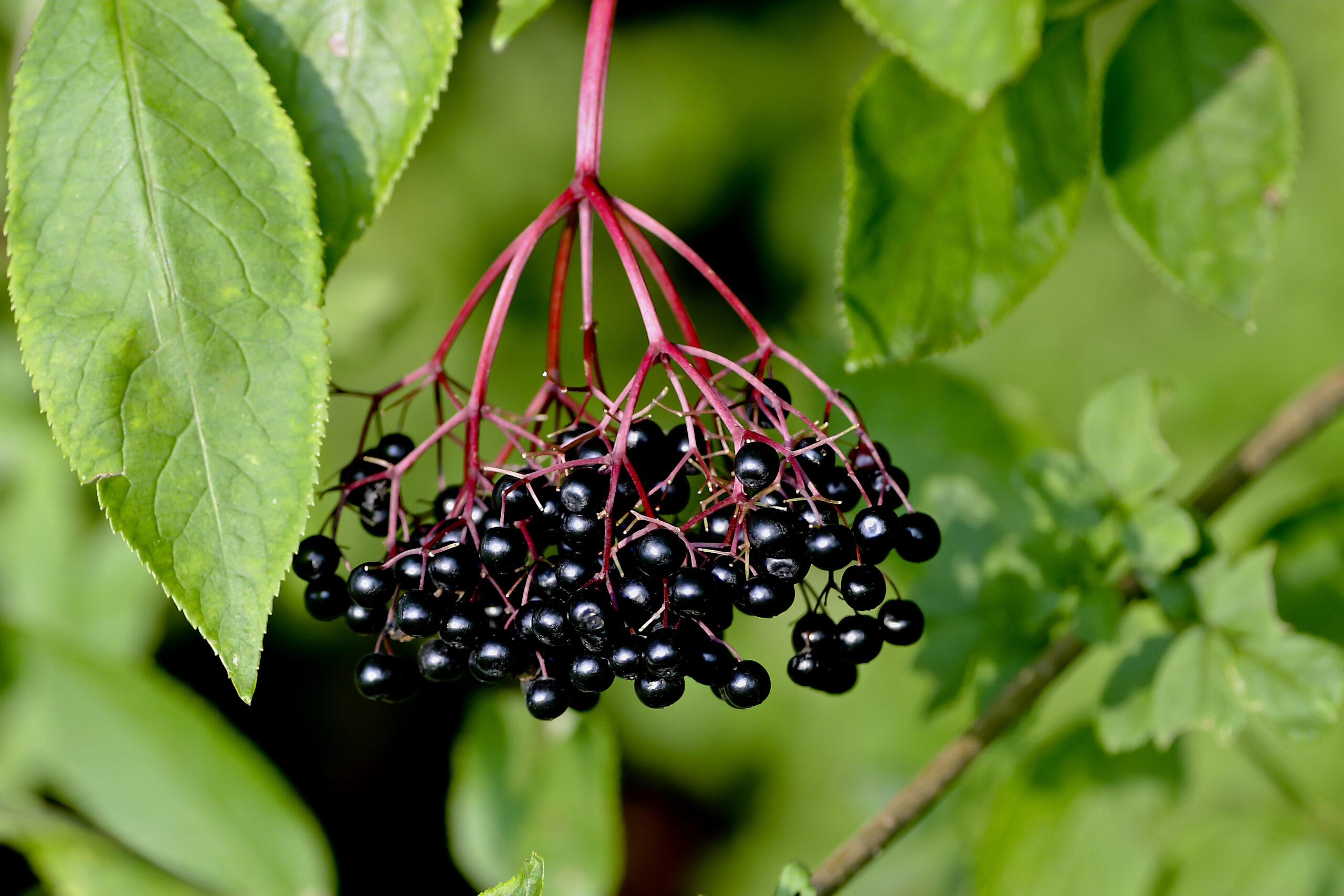Sambucus — commonly called elderberries or elder–are fast-growing, wild-looking plants that bear berries that attract birds.
Sambucus is best grown in informal gardens or in wild gardens where they can naturalize. Sambucus can be used as a screen or windbreak.
There are black-, blue-, and red-fruited elders. The berries are used to make elderberry wine and herbal pain relievers. Red fruits can cause nausea in humans if consumed raw in large quantities. The fruits are generally safe when cooked.
Sambucus is a genus of about 25 species of herbaceous perennials and deciduous shrubs and trees. Sambucus is native to woodland and thickets in temperate and subtropical Eurasia, Africa Australia, and North and South America.

Get to know Sambucus
- Plant type: Deciduous shrubs or trees
- Growing zones and range: Varries
- Hardiness:
- Height and width: 3 or more feet (.9m) a year, to 6-15 feet (1.8-4.6m) tall with an equal spread
- Growth rate: Fast
- Form and habit: Bold mounds
- Foliage: Coarse fern-shaped leaves, each with five to nine leaflets; opposite, pinnate leaves and dense
- Flowers: Flat-topped umbels or panicles of small, 5-10 inch (12.7-25.4cm) clusters of tiny creamy white flowers; the flower heads are also used in wine making
- Fruits: Blue-black berries or red berries in late summer and early fall
- Bloom time: Early to midsummer
- Uses: Shrub border or wild garden; may be better known for their folk uses—elderberry wine, pancakes, and an herbal pain reliever; not recommended for small gardens, some are too shaggy for gardens, but they work well for naturalizing and attracting birds, and some species for shrub borders and windbreak
- Common name: Elderberry
- Botanical name: Sambucus
- Family name: Caprifoliaceae
- Origin: Subtropical regions of Eurasia, North and tropical East Africa, Australia, and North and South America
Where to plant Sambucus
- Plant Sambucus in full sun; some need dappled shade to prevent fading.
- Plant Sambucus in moist soil generously supplemented with peat moss or leaf mold.
When to plant Sambucus
- Plant container-grown Sambucus in spring or autumn.
- Sow Sambucus seed in containers in an open frame in autumn.
Planting and spacing Sambucus
- Plant Sambucus 10-20 feet (3-6m) apart, depending on species.

How to water and feed Sambucus
- Give Sambucus regular water except as noted.
- Feed Sambucus with an all-purpose organic fertilizer in spring, though they grow strong with low-fertilizer.
How to care for Sambucus
- Sambucus plants can be left unpruned or, if they become too large, can be pruned as heavily as desired without being injured.
- Prune Sambucus in early spring before new growth can produce flowers and fruit.
- To keep Sambucus dense and shrubby, prune hard: in late dormant season, cut back all previous year’s growth to a few inches. New growth sprouts readily from stumps.
Sambucus pests and diseases
- Sambucus can develop powdery mildew, canker, dieback, rust, virus diseases, and fungul leaf spots.
- Sambucus are susceptible to attacks by borers.
- Sambucus berries are favorites for birds, so pick them promptly if you want them.
- Uncooked Sambucus fruits of red-berried species can cause nausea, vomiting, diarrhea if ingested.

Sambucus propagation
- New Sambucus plants can be started from softwood cuttings of young growth in late spring or early summer, from semihardwood cuttings of more mature growth in mid- or late summer, or from hardwood cuttings of dormant leafless growth in late fall or winter.
- Sambucus can also be propagated from root cuttings taken in spring or fall.
Sambucus varieties to grow
- Sambucus caerulea (also called S. ǵlauca and S. Mexicana), Blue elder or Elderberry, usually grows 15 feet (4.6m) tall. Its berries are black, but a whitish waxy covering called bloom (common on many fruits and berries) males them appear blue. Zones 5 to 9.
- S. canadensis, American or sweet elder, Elderberry, native to central and eastern North America. Spreading, suckering, usually grows 8-12 feet (2.4-3.7m) tall and has blue-black berries. Foliage is almost tropical looking; each leaf has seven 2-6 inch (5.1-15.2cm) long leaflets. Flat, creamy white flower clusters to 10 inches (25.4cm) wide in early summer, followed by tasty purple-black fruit. Fruit used for pies; both flowers and fruit used for wine.
- S. canadensis lacinata (also called S. canadensis dissectum, Cut-leaved elderberry, has delicate, fernlike leaves and blue-black berries.
- S. nigra, European elder, the species grows 10-20 feet (3.1-6.1m) tall and bears early-summer clusters of white flowers, smaller than those of S. canadensis. There are also 30 cultivars offering foliage that is golden (‘Aurea’), variegated (‘Marginata’), finely cut (‘Laciniata’), or even purple (‘Guincho Purple’). Zones 5 to 7.
- S. pubens, Scarlet elder, native to northern latitudes in North America. Shrubby plant, usually 2-4 feet (.6-1.2m) high, possibly reaching 15 feet (4.6m). Leaves divided into five or seven 2-4 inch (5.1-10.2cm) long leaflets. Blooms in late spring, with tall—to 5 inches (12.7cm)—loose flower clusters; inedible bright red fruit follows the flowers.
- S. racemosa ‘Plumosa Aurea’, European red elder cultivar, a multistemmed shrub 8-12 feet (2.8-3.7m) tall and wide with finely cut, compound, toothed leaflets of bright yellow or chartreuse. Tiny yellow flowers bloom in round-topped clusters in midspring, followed by bright red .3 inch (.8cm) berries. Zones 5 to 7.















